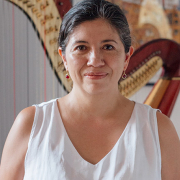The richness of chamber music
The pandemic has prevented many orchestras from being able to meet in full on the same stage, which has meant having much greater artistic rigor and redistributing the orchestra to work in multiple formats such as chamber groups.
Chamber music is music composed by a small group of instruments, as opposed to orchestral music. Generally it does not require a director. The musicians should be positioned so that they can look at each other, for better coordination. The term chamber comes from the word “room”, because originally it was music to be performed in a room, and not in a large concert hall. They generally go up to a maximum of twenty-three musicians. Classical music, as well as jazz, rock, tangos, American music, Colombian music and other rhythms can be performed in this close and welcoming experience.
For maestro Jorge Pinzón, Filarmed's resident composer, chamber music is much more demanding because each instrumentalist is more exposed to the small ensemble. “The quality of the sound, the density, the articulation of passages, as well as the musical interpretation in general must contain great efficiency and ensure maximum precision in the execution”explains Pinzón.
One of the first examples of what is now identified as chamber music appeared in England in the late 16th and early 17th centuries. At that time a large amount of music was written for groups of four to seven violas, making up what would be called viol consort or viola ensemble. On the other hand, during the Renaissance era, under the reign of King Francis I, who forced musicians to play inside their rooms, the so-called “Chantres de la chambre”. This style was also inherited by most composers such as Mozart and Beethoven, and taken to its maximum expression and quality by Brahms in the 19th century.
What is the difference between orchestral and chamber music?
The difference between these two groups is that orchestral music is determined by instrumental families, that is, the formation of woodwinds, metals, percussion and strings, in which in each family the same sounds can be duplicated, while, in the chamber groups, each instrumentalist contains independent parts, which leads to greater responsibility.
“The opportunities that the chamber musician obtains are that they require greater concentration, greater interpretive precision, and this makes the musical technical level more effective and productive when joining a symphony orchestra”says Jorge Pinzón.
Current outlook
Chamber music today plays a relevant role in our society since the technical level is constantly enriched, and on the other hand, the chamber repertoire and musical production of new composers increases. “For both the performer and the composers, it is of utmost importance to be part of these noble groups, which increasingly proliferate in an exemplary manner, exalting the musical panorama of our society,” adds Master Pinzón.













